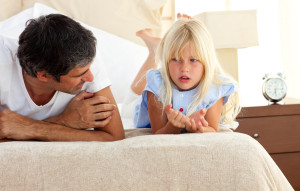Watching our kids experience anger, sadness, fear, disappointment or any challenging emotion isn’t easy. It’s so natural to want to shut it all down or fix the issue at hand. It’s uncomfortable. It’s “messy.” It pushes our buttons.
Ever felt this way? You’re not alone!
While there aren’t easy answers, there are some helpful suggestions…
When in these moments, frequent as they may be and as hard as it is, the most valuable thing you can “do” is PAUSE and s-l-o-w things down. Take a breath. Several actually. Walk away if you need to. Imagine pressing an actual pause button. Mindfully and compassionately, tune into what you’re feeling. Become aware of what buttons are being pushed by the emotions your child is experiencing. Whether or not we like to admit it, these buttons are very often about our past and/or they’re related to current life stressors we are facing, such as work, health issues, financial concerns or relationship difficulties. It is in these mindful moments that we can choose to remind ourselves, “These are my buttons, they have nothing to do with my child!”
The biggest gift we can give our children is our presence. Our non-judgmental, non-evaluative, non-critical presence. The time for learning isn’t when we and our children are in an emotional state – the time for learning is when everyone is calm.
 The path to that calm begins with us. It begins with a mindful awareness and compassionate acknowledgement that the intensity of our reaction often has more to do with our own histories and circumstances than it does with the child in front of us. It begins with an understanding that the only way our child will learn to “calm down” and regulate his emotions is when we can model what that calming down looks and feels like. In this way, we help our child learn to calm himself and accept the full range of his emotions – messy as they may be.
The path to that calm begins with us. It begins with a mindful awareness and compassionate acknowledgement that the intensity of our reaction often has more to do with our own histories and circumstances than it does with the child in front of us. It begins with an understanding that the only way our child will learn to “calm down” and regulate his emotions is when we can model what that calming down looks and feels like. In this way, we help our child learn to calm himself and accept the full range of his emotions – messy as they may be.
So, the next time you’re face-to-face with challenging emotions, PAUSE. Take care of yourself. Resist the urge to fix, dismiss or punish and instead, recognize whether you’re being triggered. Breathe. Focus on staying present and connected to your child. Become curious. Listen for the feelings beneath any behavior you see. Understand that what your child is feeling isn’t good or bad; right or wrong. It’s her experience. Set limits on hurtful actions. Allow feelings. Model respect while reminding yourself that your child is still learning how to “be” in this big, complicated world. She is doing the very best she can with the skills she currently has and needs your peaceful guidance.
Our ability to stay calm, present and aware of when our own “stuff” is getting in the way, is what builds the trust, openness and connection needed to raise confident, emotionally healthy children who thrive.
“You can’t pour from an empty cup. Take care of yourself first.”
All the best,
Debbie
